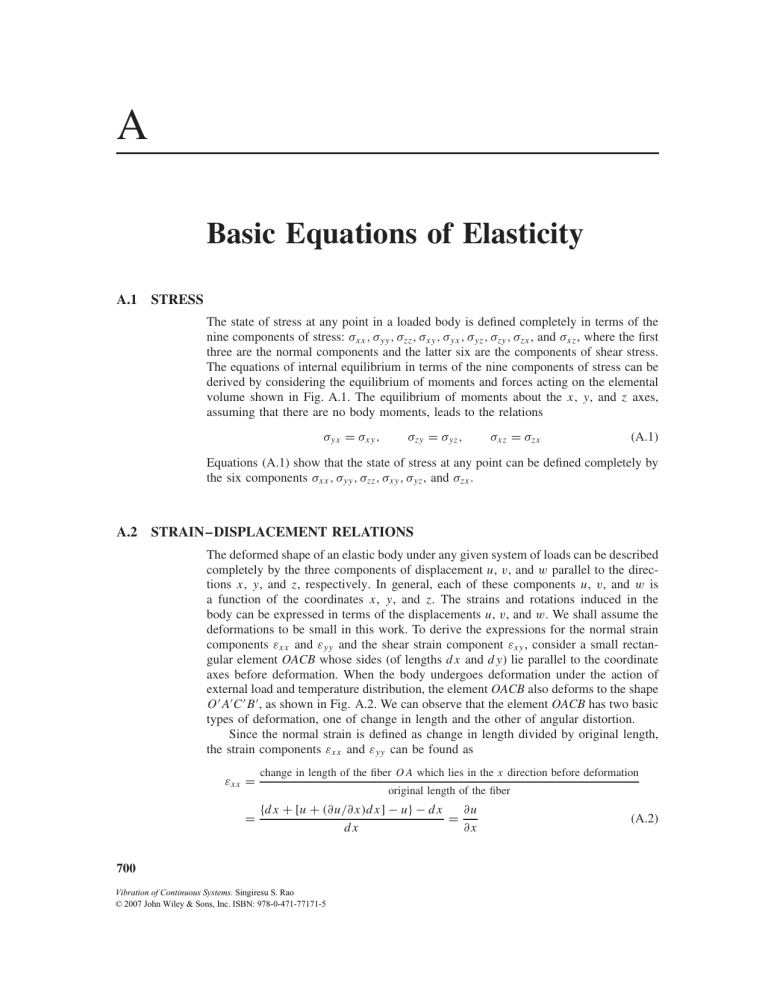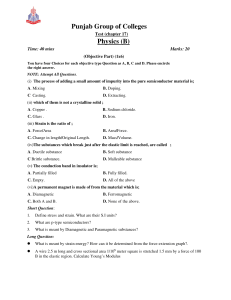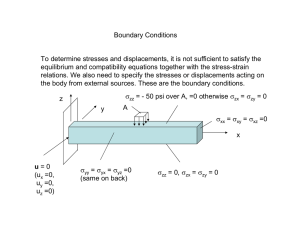
A
Basic Equations of Elasticity
A.1 STRESS
The state of stress at any point in a loaded body is defined completely in terms of the
nine components of stress: σxx , σyy , σzz , σxy , σyx , σyz , σzy , σzx , and σxz , where the first
three are the normal components and the latter six are the components of shear stress.
The equations of internal equilibrium in terms of the nine components of stress can be
derived by considering the equilibrium of moments and forces acting on the elemental
volume shown in Fig. A.1. The equilibrium of moments about the x, y, and z axes,
assuming that there are no body moments, leads to the relations
σyx = σxy ,
σzy = σyz ,
σxz = σzx
(A.1)
Equations (A.1) show that the state of stress at any point can be defined completely by
the six components σxx , σyy , σzz , σxy , σyz , and σzx .
A.2 STRAIN–DISPLACEMENT RELATIONS
The deformed shape of an elastic body under any given system of loads can be described
completely by the three components of displacement u, v, and w parallel to the directions x, y, and z, respectively. In general, each of these components u, v, and w is
a function of the coordinates x, y, and z. The strains and rotations induced in the
body can be expressed in terms of the displacements u, v, and w. We shall assume the
deformations to be small in this work. To derive the expressions for the normal strain
components εxx and εyy and the shear strain component εxy , consider a small rectangular element OACB whose sides (of lengths d x and d y) lie parallel to the coordinate
axes before deformation. When the body undergoes deformation under the action of
external load and temperature distribution, the element OACB also deforms to the shape
O A C B , as shown in Fig. A.2. We can observe that the element OACB has two basic
types of deformation, one of change in length and the other of angular distortion.
Since the normal strain is defined as change in length divided by original length,
the strain components εxx and εyy can be found as
εxx =
=
change in length of the fiber OA which lies in the x direction before deformation
original length of the fiber
{d x + [u + (∂u/∂x)d x] − u} − d x
∂u
=
dx
∂x
700
Vibration of Continuous Systems. Singiresu S. Rao
© 2007 John Wiley & Sons, Inc. ISBN: 978-0-471-77171-5
(A.2)
A.2
Strain–Displacement Relations
z
∂szz
dz
∂z
szz +
dz
szy +
∂szx
szx +
dz
∂z
syx
sxz +
syy
∂z
dz
sxx
syz +
sxy
∂sxz
dx
∂x
sxy +
0
∂szy
sxz
∂syz
∂y dy
∂sxy
∂x dx
szx
syz
sxx +
syy +
∂syx
syx +
∂y dy
∂syy
dy
∂y
y
dy
s
∂sxx zy
∂x dx
dx
szz
x
Figure A.1 Stresses on an element of size d xd yd z.
u + ∂u dy
∂y
C′
B′
v + ∂v dy
∂y
C
B
q2
A′
dy
q1
O′
y
u + ∂u dx
∂x
v
A
O
u
x
dx
Figure A.2
Deformation of an element.
v + ∂v dx
∂x
701
702
Basic Equations of Elasticity
εyy =
change in length of the fiber OB which lies in the y direction before deformation
original length of the fiber OB
∂v
{d y + [v + (∂v/∂y)d y] − v} − d y
=
=
dy
∂y
(A.3)
The shear strain is defined as the decrease in the right angle between fibers OA and
OB, which were at right angles to each other before deformation. Thus, the expression
for the shear strain εxy can be obtained as
[v + (∂v/∂x)d x] − v
[u + (∂u/∂y)d y] − u
εxy = θ1 + θ2 ≈
+
(A.4)
d x + [u + (∂u/∂x)d x] − u d y + [v + (∂v/∂y)d y] − v
If the displacements are assumed to be small, εxy can be expressed as
∂u ∂v
+
(A.5)
εxy =
∂y
∂x
The expressions for the remaining normal strain component εzz and shear strain components εyz and εzx can be derived in a similar manner as
∂w
∂z
∂w ∂v
=
+
∂y
∂z
εzz =
(A.6)
εyz
(A.7)
εzx =
∂u ∂w
+
∂z
∂x
(A.8)
A.3 ROTATIONS
Consider the rotation of a rectangular element of sides d x and d y as a rigid body by a
small angle, as shown in Fig. A.3. Noting that A D and C E denote the displacements
of A and C along the y and −x axes, the rotation angle α can be expressed as
∂u
∂v
=−
(A.9)
α=
∂x
∂y
Of course, the strain in the element will be zero during rigid-body movement. If both
rigid-body displacements and deformation or strain occur, the quantity
1 ∂v
∂u
ωz =
−
(A.10)
2 ∂x
∂y
can be seen to represent the average of angular displacement of d x and the angular
displacement of d y, and is called rotation about the z axis. Thus, the rotations of an
elemental body about the x, y, and z axes can be expressed as
1 ∂w ∂v
−
(A.11)
ωx =
2 ∂y
∂z
1 ∂u ∂w
ωy =
−
(A.12)
2 ∂z
∂x
1 ∂v
∂u
ωz =
−
(A.13)
2 ∂x
∂y
A.4 Stress–Strain Relations
703
y
B′
C
B
A′
C′
E
dy
a
a
O
D
x
A
dx
Figure A.3
Rotation of an element.
A.4 STRESS–STRAIN RELATIONS
The stress–strain relations, also known as the constitutive relations, of an anisotropic
elastic material are given by the generalized Hooke’s law, based on the experimental
observation that strains are linearly related to the applied load within the elastic limit.
The six components of stress at any point are related to the six components of strain
linearly as
σxx
σ
yy
σzz
σ
yz
σ
zx
σxy
C11
C21
C
= 31
·
·
C61
C12
C22
C32
·
·
C62
C13
C23
C33
·
·
C63
···
···
···
···
···
···
C16
C26
C36
·
·
C66
ε
xx
ε
yy
εzz
εyz
εzx
εxy
(A.14)
where the Cij denote one form of elastic constants of the particular material.
Equation (A.14) has 36 elastic constants. However, for real materials, the condition
for the elastic energy to be a single-valued function of the strain requires the constants Cij to be symmetric; that is, Cij = Cj i . Thus, there are only 21 different elastic
constants in Eq. (A.14) for an anisotropic material.
For an isotropic material, the elastic constants are invariant, that is, independent of
the orientation of the x, y, and z axes. This reduces to two the number of independent
elastic constants in Eq. (A.14). The two independent elastic constants, called Lamé’s
elastic constants, are commonly denoted as λ and µ. The Lamè constants are related
704
Basic Equations of Elasticity
to Cij as follows:
C11
C12
C44
all other Cij
=
=
=
=
C22 = C33 = λ + 2µ
C21 = C31 = C13 = C32 = C23 = λ
C55 = C66 = µ
0
(A.15)
Equation (A.14) can be rewritten for an elastic isotropic material as
λ + 2µεxx
λ + 2µεyy
λ + 2µεzz
µεyz
µεzx
µεxy
(A.16)
= εxx + εyy + εzz
(A.17)
σxx
σyy
σzz
σyz
σzx
σxy
where
=
=
=
=
=
=
denotes the dilatation of the body and denotes the change in the volume per unit volume
of the material. Lamé’s constants λ and µ are related to Young’s modulus E, shear
modulus G, bulk modulus K, and Poisson’s ratio ν as follows:
µ(3λ + 2µ)
(A.18)
E=
λ+µ
G=µ
K =λ+
ν=
or
(A.19)
2
3µ
λ
2(λ + µ)
νE
(1 + ν)(1 − 2ν)
E
µ=
=G
2(1 + ν)
λ=
(A.20)
(A.21)
(A.22)
(A.23)
A.5 EQUATIONS OF MOTION IN TERMS OF STRESSES
Due to the applied loads (which may be dynamic), stresses will develop inside an
elastic body. If we consider an element of material inside the body, it must be in
dynamic equilibrium due to the internal stresses developed. This leads to the equations
of motion of a typical element of the body. The sum of all forces acting on the element
shown in Fig. A.1 in the x direction is given by
∂σxy
∂σxx
d x d y d z − σxx d y d z + σxy +
d y d x d z − σxy d y d z
Fx = σxx +
∂x
∂y
∂σzx
+ σzx +
d z d x d y − σzx d x d y
∂z
=
∂σxy
∂σxx
∂σzx
dx dy dz +
dx dy dz +
dx dy dz
∂x
∂y
∂z
(A.24)
A.6
Equations of Motion in Terms of Displacements
705
According to Newton’s second law of motion, the net force acting in the x direction
must be equal to mass times acceleration in the x direction:
Fx = ρ d x d y d z
∂ 2u
∂t 2
(A.25)
where ρ is the density, u is the displacement, and ∂ 2 u/∂t 2 is the acceleration parallel
to the x axis. Equations (A.24) and (A.25) lead to the equation of motion in the x
direction. A similar procedure can be used for the y and z directions. The final equations
of motion can be expressed as
∂σxy
∂σxx
∂σzx
∂ 2u
+
+
=ρ 2
∂x
∂y
∂z
∂t
(A.26)
∂σyy
∂σyz
∂σxy
∂ 2v
+
+
=ρ 2
∂x
∂y
∂z
∂t
(A.27)
∂σyz
∂σzx
∂σzz
∂ 2w
+
+
=ρ 2
∂x
∂y
∂z
∂t
(A.28)
where u, v, and w denote the components of displacement parallel to the x, y, and z
axes, respectively. Note that the equations of motion are independent of the stress–strain
relations or the type of material.
A.6 EQUATIONS OF MOTION IN TERMS OF DISPLACEMENTS
Using Eqs. (A.16), the equation of motion, Eq. (A.26), can be expressed as
∂
∂
∂ 2u
∂
(λ + 2µεxx ) +
(µ εxy ) +
(µεxz ) = ρ 2
∂x
∂y
∂z
∂t
(A.29)
Using the strain–displacement relations given by Eqs. (A.2), (A.4), and (A.8),
Eq. (A.29) can be written as
∂
∂x
λ + 2µ
∂u
∂x
+
∂
∂y
∂v
∂u
∂
∂w ∂u
∂ 2u
µ
+
+
µ
+
=ρ 2
∂x
∂y
∂z
∂x
∂z
∂t
(A.30)
which can be rewritten as
(λ + µ)
∂ 2u
∂
+ µ∇ 2 u = ρ 2
∂x
∂t
(A.31)
where is the dilatation and ∇ 2 is the Laplacian operator:
∇2 =
∂2
∂2
∂2
+
+
∂x 2
∂y 2
∂z2
(A.32)
706
Basic Equations of Elasticity
Using a similar procedure, the other two equations of motion, Eqs. (A.27) and (A.28),
can be expressed as
(λ + µ)
∂ 2v
∂
+ µ∇ 2 v = ρ 2
∂y
∂t
(A.33)
(λ + µ)
∂
∂ 2w
+ µ∇ 2 w = ρ 2
∂z
∂t
(A.34)
The equations of motion, Eqs. (A.31), (A.33), and (A.34), govern the propagation of
waves as well as the vibratory motion in elastic bodies.

